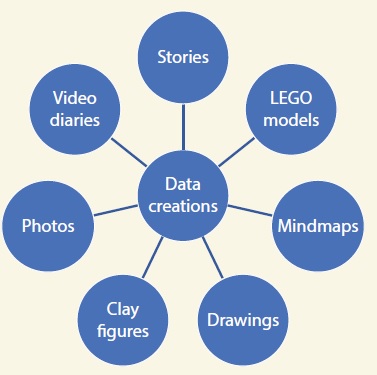INNOVATIVE DATA
GENERATION METHODS
‘Data collection’ and ‘data generation’ are sometimes used
interchangeably. Both terms refer to the methods that are used to gather data
for analysis. However, ‘data collection’ hints that the researcher remains
outside the creation of that data – potentially the data might have evolved
without the researcher’s presence or involvement. ‘Data generation’ hints that
the researcher is either an active participant in the creation of data or they
may have arranged a situation in which rich data became available.
At first glance, the researcher’s position as an active
participant (or even a research instrument) might suggest that the data
produced is potentially too subjective or biased. However, qualitative
researchers argue that innovative methods in data generation can evoke rich
insights and new ideas which, in turn, could lead to new theories, perspectives
or understandings. These new ideas are the seeds from which new products,
practices or services could develop.
Innovative methods don’t always require completely new
products or practices to work. Sometimes they involve doing familiar activities
in different ways. For example, an interview does not have to involve a
face-to-face conversation between the researcher and one participant – it could
be managed via a videoconferencing platform, via telephone, or as part of a
group. The interview doesn’t have to stay still – it could be conducted as a
walk-along interview, where the researcher joins the participant as they
conduct their daily activities. As an example, walk-along interviews can help
researchers to gain insights into the daily lives of their participants and may
give them access to a deeper understanding of any conflicting priorities that
may impact on the participants’ decisions.
Data generation can also involve getting the participants to
make something or bring an artefact that reflects their thoughts, feelings, or
experiences with the issue(s) of interest to the researcher. Any artefact that
a participant brings with them to an interview might be used as a starting
point to enrich the conversation that takes place within the interview. This
allows the participant to have more control over how the conversation
progresses – because part of the conversation will involve them talking about
the meanings they associate with the issue to hand. Using an artefact as a
visual prompt for discussion allows both researcher and participant to focus
their conversation on the key issues, limiting any time wastage in the process.
The data creations identified in the diagram below represent
a small selection of the innovative research methods used in recent research
projects.

Some of these creations may be self-explanatory. For
example, photos or screenshots could illustrate an important event in the
participant’s life, what they are working on at the time of the interview or
even where they are standing when a telephone interview takes place. Arts-based
creations like clay figurines, LEGO models or drawings can be useful ways of
exploring how the participant feels about something or how they connect various
aspects of their lives. Clay figurines could represent various elements that
impact on their decisions, so the placement of figurines on a table could show
how the participant views these issues. Self-portraits (as drawings or models)
can be used as a starting point from which to discuss issues of identity.
Making clay figurines or LEGO models could be used as part of a group
interview, in which participants create a physical representation of a complex
idea to explain their views or experiences. Making models in a group setting
will also reduce the formality of the interview process, making people more
comfortable as they participate.
Stories can be used as artefacts during an innovative
interview process. The stories could be provided as a written artefact, with
the participant explaining why the story is significant to them and to the
issue at the centre of the research. Stories can also be spoken, recorded as a
reference, be written by the participant – or collaboratively written with the
researcher. The act of sharing a story –
and listening carefully as it is told – can create strong relationships between
participant and researcher, allowing the researcher to gain deeper insights
into the participant’s thoughts and feelings, enriching the data collected and
further reducing the barriers between researcher and participant.
Using innovative research methods can be an exciting aspect
of any research project. However, any research methods used need to be
appropriate to the project at hand, should generate data that is relevant to
the research project and not waste time.
Both the participants and the researchers need a clear understanding of
the purpose underlying any research method.
If the research methods make sense to all parties and don’t require a
heavy burden of preparation for the participant, then the chosen methods are
likely to generate valuable data.
Learn more - Study our research course - available though this web site.